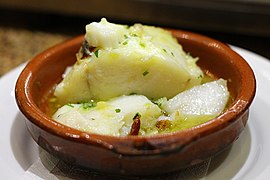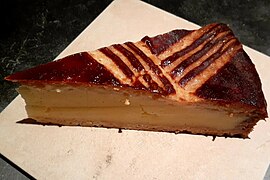Basque cuisine
Basque cuisine refers to the cuisine of the
.A basquaise is a type of dish prepared in the style of Basque cuisine that often includes tomatoes and sweet or hot red peppers.
Overview
Basques have also been quick to absorb new ingredients and techniques from new settlers and from their own trade and exploration links.
Olive oil is more commonly used than vegetable oil in Basque cooking.[1]
One of the staple cookbooks for traditional Basque dishes was initially published in 1933. "La cocina de Nicolasa" (the Kitchen of Nicolasa) by Nicolasa Pradera has gone into 20 editions.[2]
Ways of eating
In addition to the dishes and products of the Basque Country, there are features of the way of preparing and sharing food unique to the area.
Cider houses (sagardotegiak) are a feature of the hills around Donostia, especially near Astigarraga. These are usually large country restaurants with enormous barrels of cider. Cider is poured from a height straight into the glass for visitors, with a rustic menu invariably of salt cod omelette, grilled T-bone steak and ewes' milk cheese with walnuts and quince paste. The cider houses are only open for a few months of the year.
The txikiteo is the tapas crawl from bar to bar seen across Spain, but it reaches its pinnacle in
.Many bars will offer a combination of pre-made pintxos (such as gildas) that are typically cold as well as hot specialities that are made to order. Typically pintxos cost between one to three euros each.[3][4]
Gerezi beltza arno gorriakin[5] is a cherry soup served warm or cold. The cherries are poached in wine, often with enough sugar added to make a light syrup. A cherry without pits is preferred for this dish. To release their flavor, the cherries are carefully pitted or cut in half. Usually the soup is prepared on the day it will be served, because 24 hours is enough time for the cherries to blanch noticeably in the liquid. The soup is often served with a dollop of sour cream, crème fraîche, or ice cream.
Gastronomic societies are organisations, almost always of men, who cook and eat together in a communal txoko.
Culture of Basque Country |
|---|
 |
| Mythology |
| Literature |
New Basque Cuisine
In the 1970s and 1980s Basque chefs were influenced by the nouvelle cuisine of France and created the nouvelle cuisine basque, radically original in its form but solidly Basque in substance, with lighter and less rustic versions of traditional dishes and flavours. The first Spanish restaurant to be awarded 3 stars in the Michelin Guide was, in fact, Zalacaín, a Basque restaurant, although located in Madrid. Juan Mari Arzak in Donostia became the most famous exponent and one of the first three-star Michelin Guide restaurants in Spain. In a few years the movement swept across Spain, becoming the state's default
International Basque cuisine
Basque cuisine has continued to have an influence on international cuisine, particularly in Spain and France where it is highly regarded.
Traditional dishes and desserts
-
Bacalao al Pil-Pil
-
Piperrada
-
Txuleta
-
Merlu koxkera
Dishes
- Bacalao (salt cod) al Pil-Pil or a la Vizcaína
- Elvers (young eel)
- Kokotxas (cheeks of hake)
- Marmitako
- Percebes (Gooseneck barnacles)
- Pintxos (Basque tapas)
- Piperade (or Piperrada)
- Pisto
- Porrusalda (sukaldaritza)
- Talos
- Ttoro
- spider crab)
- Txipirones (baby squid) in their ink
- Txuleta
Desserts
- Cuajada (Mamia)
- Gâteau Basque (or Biskotx)
- Goxua
- Intxaursaltsa
-
Gâteau basque
-
Goxua
-
Intxaursaltsa
Products
-
Idiazabal cheese
-
Txistorra
-
Jambon de Bayonne
Cheeses
Fruits and vegetables
- Artichokes from Tudela
- Asparagus from Mendavia
- Beans from Tolosa
- Gernika and Lodosa
- Cherries from Itxassou
Meats
- Chistorra and chorizo de Pamplona (spicy sausage)
- Jambon de Bayonne(cured ham)
- Sausages from Viana
- Tripotx (lamb blood-sausage from Biriatou)
- Mondeju, similar to tripotx from Zaldibia
- Lukainka, similar to linguiça
Beverages

- Basque cider served in Basque cider houses (Sagardotegi)
- Irouléguy AOC wine
- Izarra liqueur
- Kalimotxo, a mixture of wine and cola
- Patxaran liqueur
- mandrake-root liqueur)
- Txakoli wine
References
- OCLC 68571142.
- ^ "Nicolasa Pradera (1870-1959)". Markina-Xemein (in Spanish). Markina-Xemein, Spain: Markina-Xemein Town Hall. Archived from the original on 25 September 2015. Retrieved 25 September 2015.
- ^ "A Brief History Of Pintxos The Basque Country's Favourite Snack". Culture Trip. 2017-03-24. Retrieved 2024-01-13.
- ^ Turansky, Maggie (2022-04-12). "The Ultimate 2 to 3 Days in San Sebastian Itinerary". The World Was Here First. Retrieved 2024-01-13.
- ISBN 0-06-757461-0., page 214
- ^ "Real Academia de Gastronomía. Premios". Archived from the original on 2014-04-18. Retrieved 2014-04-18.
- ^ "Search".
- ^ Shaffer, Charles L. "Basque Restaurants of the United States". Buber.net. Retrieved 20 November 2014.
Further reading
- Barrenechea, Teresa (1998), The Basque Table, The Harvard Common Press ISBN 1-55832-140-3
- Maznik, Yasna (2002), The Basque Country, Hachette (publishing) ISBN 1-84202-159-1
External links
![]() Media related to Cuisine of the Basque Country at Wikimedia Commons
Media related to Cuisine of the Basque Country at Wikimedia Commons










